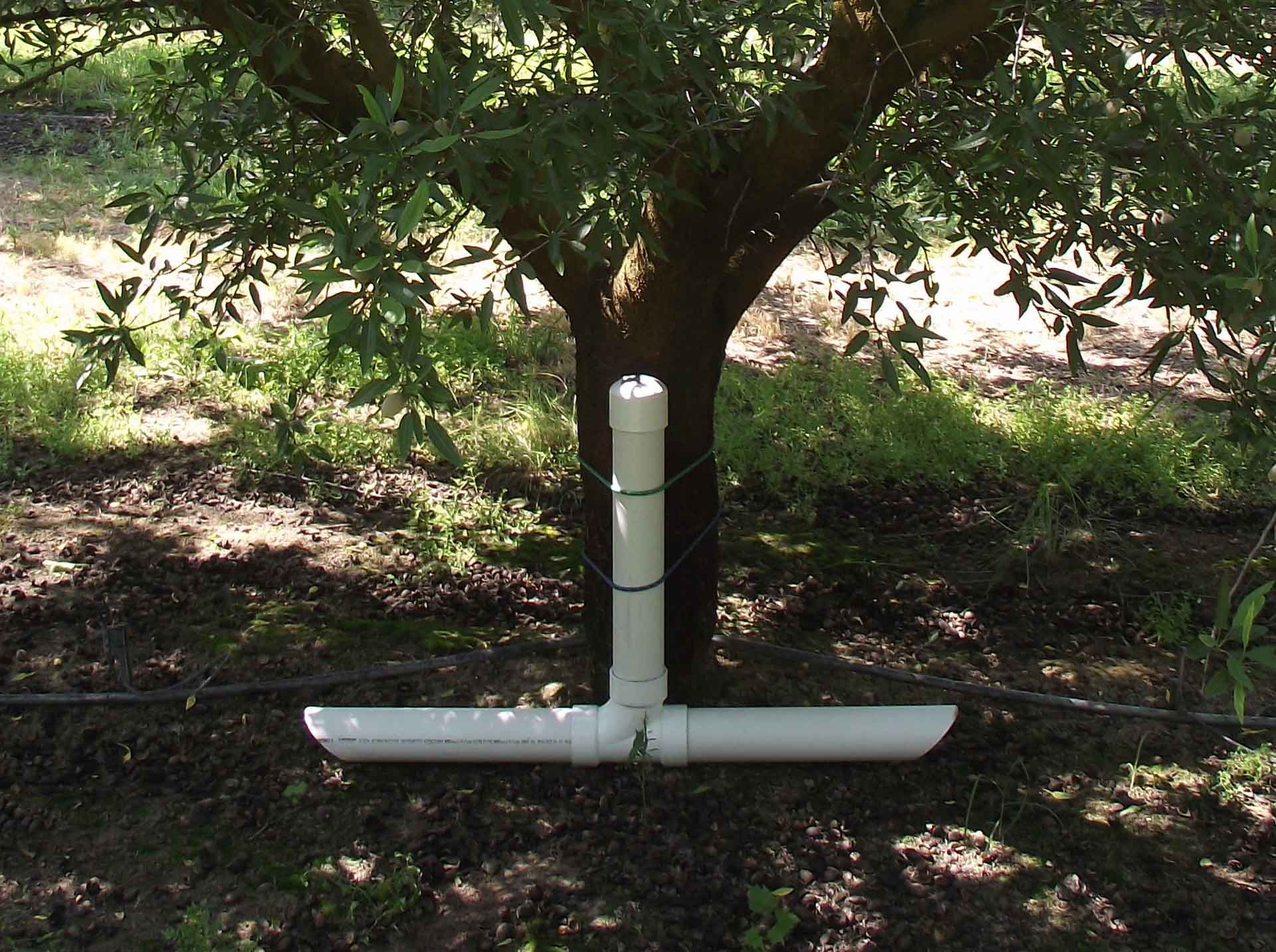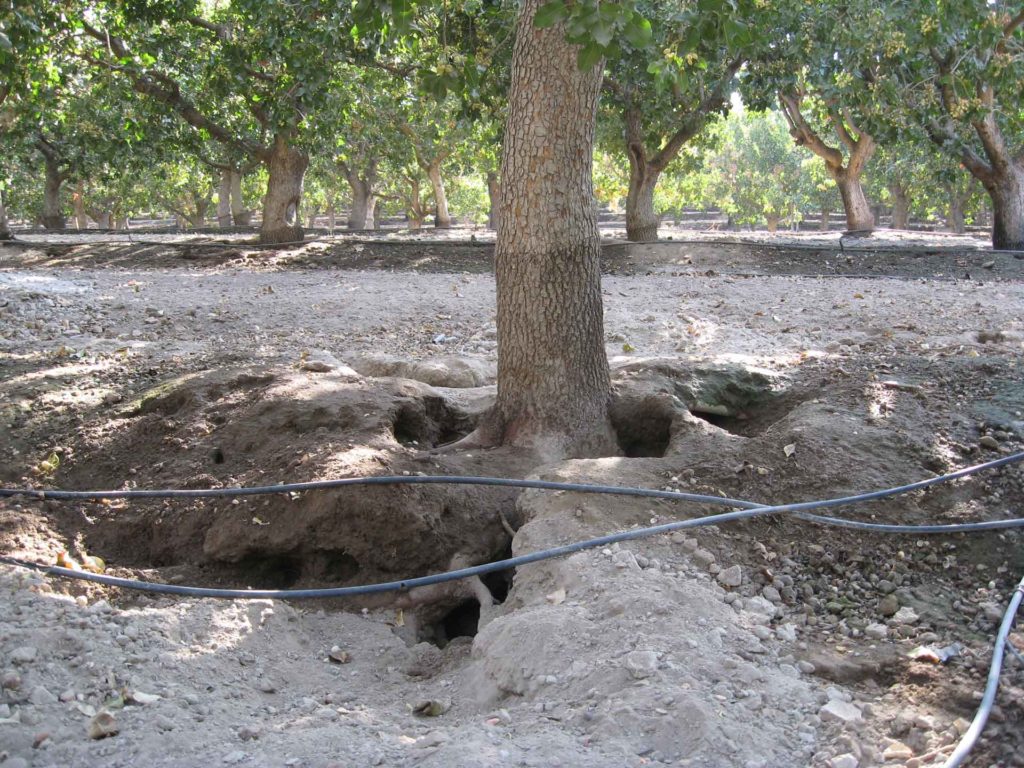They don’t look that destructive in Disney movies, but vertebrate pests in almond orchards can drive growers and managers nuts.
Vertebrate pests run the gamut from coyotes to ground squirrels, to voles and even roof rats. Depending on the species, they can cause yield losses by feeding on nuts, pose food safety issues in the orchard, and damage irrigation lines. Their burrows can slow harvest, damage equipment and pose safety hazards for workers and livestock. Some vertebrate species can also transmit diseases to humans.
Vertebrate Pest Pressure
Roger Baldwin, a University of California Cooperative Extension (UCCE) specialist in the Department of Wildlife, Fish and Conservation Biology at UC Davis, said vertebrate pest pressure may depend on the growing region or local environmental conditions, but in general, ground squirrels are the primary culprits in orchards. Roof rats feeding in almond orchards are a recent issue in some areas. Orchards near riparian areas are most vulnerable and may also be invaded by raccoons.
Growers or orchard managers who find evidence of vertebrate pest feeding, burrows or mounds in orchards or holes in irrigation lines need to first identify the problem pest so it can be successfully managed.
California Ground Squirrel
The California ground squirrel, found throughout most of the state, can invade and quickly colonize an orchard. Ground squirrels live in burrow systems where they sleep, eat, rear young and store food. The burrows are about four inches in diameter although sometimes substantially larger, and their length can vary from five to 30 feet. Most systems are within two to three feet of the surface of the ground. The burrows alone are destructive as they can damage tree roots, are hazardous to machinery or workers and, at harvest time, can slow harvest and swallow up a significant number of nuts if the entrance is large.
Understanding the life cycle of this pest will help make management more effective.
Depending on weather and elevation squirrel reproduction can begin as early as late January. Males often emerge 10-14 days before females. Peak mating season is March-June. Gestation is 23-28 days. Females produce one litter per year.
Squirrels become inactive for two periods during the year. Estivation is the period of dormancy that takes place during extreme heat in July and August. Squirrels also hibernate during the colder months, but can emerge as early as January.
Baiting
Squirrels feed on grasses or other plants in the spring and transition to seeds and nuts in the summer when they begin to store food. Baiting with treated grain works best after vegetation has dried.
There are two types of rodenticides used in baits and most are restricted use pesticides. Baldwin noted that it is important to follow the label for all products. First generation anti-coagulants are multiple feed materials, meaning the targeted pest generally needs to ingest it over several days. It may take slightly longer to see results with the anti-coagulants, but there is typically less bait shyness and they are a safer product to use when concerned about direct consumption of bait by non-target animals. These anti-coagulants can be applied via spot treatments, placed around burrow openings; broadcast over wide areas or placed in bait stations where they are protected from the elements. Ground squirrels usually forage close to their burrows- within about a 75-yard radius.
Zinc phosphide is an acute toxicant and provides more rapid control. Less of the material is needed than with anti-coagulants, making it less expensive. Risks to non-target animals through direct consumption are higher and the bait is not always as acceptable due to odor and taste.
Pests killed by either of the products should be removed promptly as non-targeted wildlife can be poisoned if they feed on the carcasses. Carcasses of animals killed by zinc phosphide generally have low secondary toxicity risk, making it a preferred option where secondary toxicity is a substantial concern.
The UC website: www.groundsquirrelbmp.com lists other control measures that have only moderate success. Those include trapping, shooting, repellants and burrow modification.
Irrigation Lines
Along with coyotes, ground squirrels are likely culprits when it comes to damaged irrigation lines. Baldwin said there is no evidence these pests are chewing to obtain drinking water. Rodents explore and chew on objects in their environment and the plastic lines are handy. Coyotes, and especially their young, are doing what many domestic dogs do-chew on things. The problem may be short term with coyotes as the pups grow and leave. Squirrel chewing more of a constant issue, Baldwin said.
If coyotes are suspected in damage to plastic irrigation pipe, growers should look for evidence including tracks, scat or large tooth marks. Baldwin said the chewing is rarely an ongoing issue and often ends when the young pups move on to live prey—which means they can help with the rodent issue. If damage becomes extensive, professional assistance is usually required to remove the responsible coyotes as selectively and as efficiently as possible.
Pocket Gophers
Other burrowing vertebrates that may pose problems in a nut orchard are voles and gophers. Pocket gophers can be serious pests, feeding on bark of tree crowns and roots. They are active throughout the year and if uncontrolled and food is plentiful, can increase to 30 to 40 individuals per acre. In nut orchards they are more likely to damage a cover crop than to cause serious injury to bark or roots of mature trees. They do regularly girdle and kill young trees though. Pocket gophers also chew on buried irrigation lines.
Pocket gophers remain active year-round. Surface activity decreases on hot, dry lowlands during summer and during and after heavy rains. Gnawing or girdling of young orchard trees is most likely to occur during late summer when the ground is dry and green vegetation is scarce.
Pocket gopher and mole mounds are often confused. Mole mounds are volcano or conical shape in appearance. Pocket gopher mounds are usually crescent or horseshoe shaped with a plug located toward the lower portion of one side of the mound. It is important to note which species is invading the orchard as management options for each are different.
Management
Pocket gopher management can be particularly effective in late fall through late winter when mounding activity is high. The UC Integrated Pest Management Vertebrate Pest Management Handbook advises that the most effective long-term strategy for managing pocket gophers will require use of multiple approaches. Due to their inconsistent mound creation, a single treatment may miss part of the population, making multiple treatments necessary.
Burrow fumigation, trapping, and baiting appear to be the most effective control options. First generation anticoagulants such as chlorophacinone and diphacinone, zinc phosphide and strychnine are the primary toxic bait labeled for this pest. The handbook notes that pocket gophers develop behavioral or physiological resistance to strychnine and it should only be used as part of an integrated pest management (IPM) program.
All pocket gopher bait is applied below ground. There are three primary methods for baiting: 1) hand baiting via the funnel and spoon method, 2) an all-in-one probe and bait dispenser, and 3) a mechanical burrow builder. Preventative perimeter treatments using burrow builders around orchard blocks or crop fields (up to three rows, 20-30 feet apart) made two to three times per year can reduce pocket gopher migration into crops BEFORE damage occurs.
Voles and Meadow Mice
Voles, or meadow mice damage trees by chewing on bark and even girdling young trees. These mouse-like rodents spend more time above ground than gophers, but have underground burrows.
Removing vegetative cover can change their habitat enough so they seek more favorable conditions. If infestations are heavy, baiting with products similar to those for squirrels will work. Chlorophacinone is labeled for year-round crop border broadcast; most anticoagulants and zinc phosphide baits are labeled for broadcast in dormant orchards and for use in bait stations around the perimeter.
Burrow fumigants such as gas cartridges aren’t effective for controlling voles, because their burrow system is shallow and has numerous open holes. Electromagnetic or ultrasonic devices and flooding are also ineffective against voles.
When it comes to disease transmission, the primary concerns are Hantavirus, Colorado tick fever and Leptospirosis. Ground squirrels, wood rats and mice can be hosts of Colorado tick fever and is transmitted by a bite from an infected tick.
Leptospirosis is caused by bacteria that can be harbored in many rodent species that show no signs of illness. The bacteria can be spread to pets and humans via urine from an infected rodent.

Cecilia Parsons
Cecilia Parsons has lived in the Central Valley community of Ducor since 1976, covering agriculture for numerous agricultural publications over the years. She has found and nurtured many wonderful and helpful contacts in the ag community, including the UCCE advisors, allowing for news coverage that focuses on the basics of food production.
She is always on the search for new ag topics that can help growers and processors in the San Joaquin Valley improve their bottom line.
In her free time, Cecilia rides her horse, Holly in ranch versatility shows and raises registered Shetland sheep which she exhibits at county and state fairs during the summer.

















